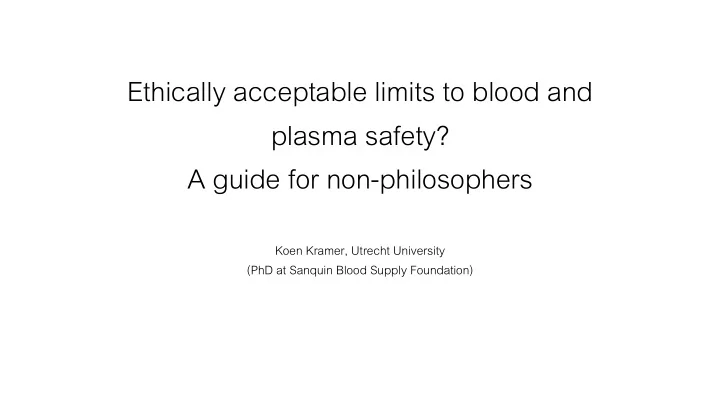

Ethically acceptable limits to blood and plasma safety? A guide for non-philosophers Koen Kramer, Utrecht University (PhD at Sanquin Blood Supply Foundation)
Content Background: blood safety & cost-effectiveness Research question Argumentative baseline: utilitarian argument to limit safety Non-utilitarian counterarguments (empirical & desk study) A way forward & lessons
Background: blood safety & cost-effectiveness
Background: blood safety & cost-effectiveness Some safety measures… • Address low residual risks • Involve relatively high costs … And thus have high incremental cost -effectiveness ratios • HCV/HIV/HBV-NAT, anti-HTLV I/II: > € 1,000,000/QALY (Borkent-Raven et al. 2012)
Research question (When) is setting limits to blood safety ethically acceptable?
1) Argumentative baseline: utilitarian argument P1: (~utilitarian): It is ethically right to increase population health P2: Setting limits to blood safety saves money P3: Money saved can be used to fund more efficient care P4: Funding more efficient care leads to increased population health C: Therefore, it is ethically right to limit blood safety Accepted as an argumentative baseline: • It is prima facie ethically right to limit blood safety • Are there compelling counterarguments?
2) Bracketing utilitarian counterarguments Several premises in utilitarian argument from health economics • Not my expertise • Seem robust (cf. proposed CE limits & ICERs in blood safety) Non-utilitarian arguments barely explored: • ‘We should not set limits to blood safety even if doing so would enable increasing population health ’ • Possibly overriding considerations, e.g. justice, responsibility, relationship
3) Generating non-utilitarian counterarguments Literature study • Ethics of blood safety • Medical ethics Qualitative empirical research • Analysis of policy documents (Kramer et al. 2015) • Interviews & focus group discussions (Kramer et al. 2019)
4) Evaluating non-utilitarian counterarguments The “Rule of rescue” argument (Verweij & Kramer 2016) The “Imposed risk” argument (Verweij & Kramer 2016) The “Manufacturing standard” argument (Verweij & Kramer 2016) The precautionary principle (Kramer et al. 2017a & 2017b) Stopping vs. not starting safety measures (Kramer et al. 2017c)
Example: the “Imposed risk” argument P1: Not imposing risk may cost more than preventing (‘extrinsic’) risk P2: Not taking blood safety measures means imposing risks C: Blood safety measures may cost more than preventing risks Evaluation: • P1 accepted for the sake of argument • Does not taking safety measures mean imposing risks? • C does not imply that ICERS > € 1,000,000/QALY are acceptable
Example: the “manufacturing standard” argument P1: CE not a legitimate concern for safety of manufactured drugs P2: Blood products are manufactured drugs C: CE not a legitimate concern for safety of blood products Evaluation: • P2 accepted for the sake of the argument • P1 depends on opportunity cost: private vs. public
A way forward? Burden of proof has shifted (?): offer arguments not to limit safety • Insufficient for policy • Qualitative empirical work (Kramer et al. 2019) generates further arguments
A way forward? Evaluate further non-utilitarian counterarguments • E.g. “Double bad luck” argument, “bodily integrity” argument
A way forward? Evaluate utilitarian argument & counterarguments • Stakeholders often accept the utilitarian argument in principle… “Of course I want to run as little risk as possible. But I am realistic in understanding that it’s not only about me. (. . .) Yo u can’t expect society to spend its money on an individual rather than helping a larger group .” (R07 -27 & R07-28) • ...but often reject its economic premises “If I start calculating and cut costs seriously (…) I end up saving around 20 million euros (…) 20 million is nothing in heal th care.” (P07 -28)
Lessons (or discussion points)? • Clear argumentative strategies can advance blood safety debates • The utilitarian argument is a good argumentative baseline • Ethics & qualitative empirical research have a role to play
Thanks for your attention! K.Kramer@uu.nl
Recommend
More recommend